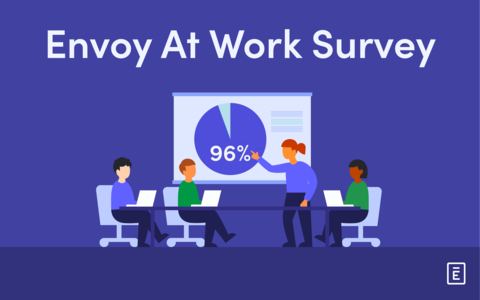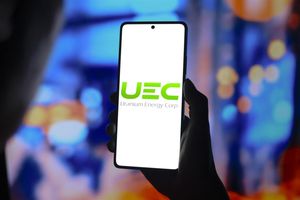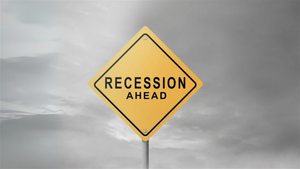Yet, almost half of employees believe where you work doesn’t matter
Today, Envoy released its latest At Work Survey which compares the experiences of U.S. employees and executives as they explore what it means to work from the office today. This survey takes a look at how each group views the workplace and its purpose, as well as office taboos, and of course, the critical workplace dealbreakers.
This press release features multimedia. View the full release here: https://www.businesswire.com/news/home/20220928005262/en/

Envoy released its latest At Work Survey which compares the experiences of U.S. employees and executives as they return to the physical office. (Graphic: Business Wire)
People are returning to a more flexible, and in many ways community-focused, workplace.
Employees and leaders agree that there’s power in gathering at the office a few times a week to collaborate, share and problem-solve. 76% of office workers say being in the office is good for their mental well-being. Most leaders (94%) and employees (84%) feel that office work life provides a sense of community. In-person touchpoints are helping develop rapport, which builds stronger relationships for better cross-functional work.
However, significant gaps exist in how executives and employees view the workplace. For instance:
According to leaders, where you work matters. For employees, not so much.
- Despite greater awareness, proximity bias persists. An astounding 96% of leaders take notice of employees' work contributions more often when employees come into the office versus when they work from home.
- Yet 42% of employees disagree.1 They don’t believe that their contributions are recognized more when they work from the office.
- Gen Z employees, more than any other generation, value workplace visibility. They are the most aligned with leadership. 73%* believe their contributions are noticed more in-office than at home. Only 64% of Millennials, 53% of Gen X, and 45% of Boomers feel the same.
- Among executives, women are more likely than men to recognize work and contributions accomplished from home.
Employees agree that the most important outcome when working in the office is productivity. Executives are split.
- When asked which is the most important result when working in an office--productivity or building relationships with coworkers--over two-thirds of employees (67%) chose productivity. Only 56% of executives agreed.
- Executives are split on the issue. 44% of leaders see relationship building as the priority which could reflect varying company values.
-
Female executives, younger executives, and those newer in their position are more likely to say productivity is the most important outcome.
- 67%* of women executives think productivity is more important than relationship building while only 52% of their male counterparts think likewise.
- 64%* of executives under 40 think productivity is more important compared with 51% who are over 40.
- 66%* of director-level leaders versus 51% of C-suite executives think productivity is more important.
Employees worry about traditional workplace taboos – but leaders say most no longer apply.
- In the past, certain office activities were forbidden, either explicitly or presumed. Today, employees perceive activities like taking sick days or dressing casually as still on the corporate no-no list. But leaders are more accommodating these days than employees think.
- Over half (53%) of employees say there’s a stigma around leaving the office early. However, over two-thirds of executives (68%) wouldn’t view it negatively.
- 58% of employees feel bringing a pet to your workplace would be viewed poorly by managers; 66% of leaders disagree.
- Even running personal errands during the workday is considered fine with most leadership. Only 38% would frown upon it; however, 50% of employees say differently.
- The number one taboo for both leaders (48%) and employees (68%) is surfing the internet at work or watching videos online.
- The only stigma that executives view more negatively than employees is taking lunch breaks outside the office. Only 8% of employees feel this would be considered a no-no compared with 21% of executives.
Long commutes continue to top the list of workplace dealbreakers.
- The biggest workplace deal breakers for employees are long commutes (47%) and chatty coworkers (37%). Slow or outdated technology cited by 36% of employees edged out lack of flexibility as the top three concerns.
- Leaders correctly guessed their employees' top concern: long or expensive commutes (36%). But they slightly missed the mark when they cited lack of flexibility (32%), slow technology (30%) and going into the office and finding out the colleagues you need to collaborate with are not coming in (30%) as the next highest-ranking dealbreakers for employees.
- In reality, executives underestimate the impact outdated technology and chatty or difficult coworkers have on employees. Yet they overemphasize the impact of opportunities to socialize with coworkers and free food.
Leaders find it much easier than employees to leave work at work.
- When working in an office, 63% of executives feel it’s easier to leave work behind compared to working from home.
- Only 39% of employees find it easier. 28% consider it more difficult to sign off.
- Despite what leaders may believe about being able to ‘turn work off' after leaving the office, employees still find it difficult to maintain a healthy work life balance when working from the office.
At Work is a data-driven workplace report that is published twice a year and features workplace trends, survey results, Envoy‘s workplace platform data, and perspectives from workplace leaders. To find out more about proximity bias in the workplace, read our companion blog, At Work.
About This Survey
Envoy partnered with Wakefield Research to survey 1,000 U.S. office workers and 250 U.S. executives working in a physical workplace at least one day per week. “Office workers” are defined as those employed full-time, excluding those with a seniority of director or greater. "Executives" are defined as those with a minimum seniority of director. Survey responses were collected between August 8 and August 18, 2022, using an email invitation and online survey.
Data has been weighted to ensure an accurate representation of U.S. office workers who have returned to the workplace. The overall margin of error for the findings is ±3.1 percentage points for the employee survey and ±6.2 percentage points for the executive survey at a 95% confidence level.
About Envoy
Envoy is transforming modern workplaces for flexible work to bring people together so they can connect, collaborate, and thrive. Envoy’s workplace platform has redefined how companies welcome visitors, improve the employee experience, book desks and conference rooms, and manage deliveries in 16,000 locations around the globe by designing products for a flexible workplace experience. Companies like Slack, Pinterest, and Warby Parker rely on Envoy to create an unrivaled first impression and keep their offices secure and compliant.
For more information, please visit envoy.com.
________________
1Hybrid or formerly remote employees
*Small base size: findings are directional.
View source version on businesswire.com: https://www.businesswire.com/news/home/20220928005262/en/
Contacts
April Marks
media@envoy.com





